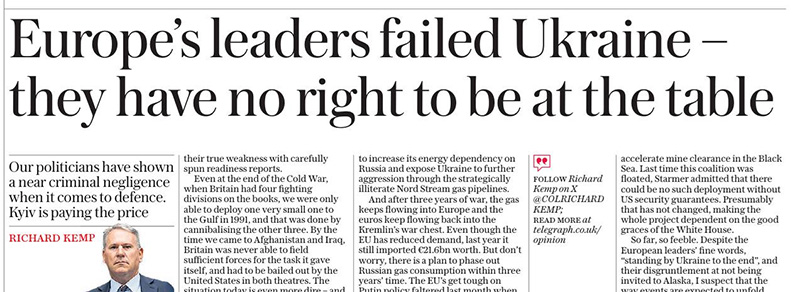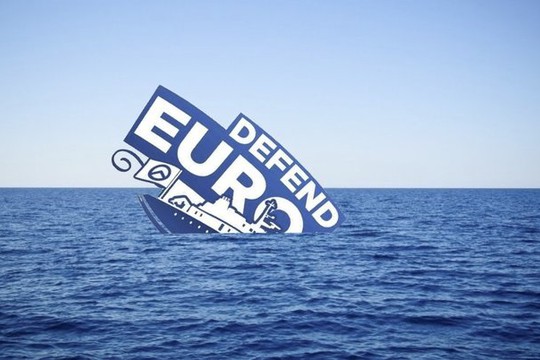Photo: realcleardefense.com
For all the bold talk of protecting Ukraine, President Trump is due to meet Putin for a summit that will involve little or no European participation, ‘The Times’ notes.
Sir Keir Starmer sought to invoke his inner statesman earlier this year when he declared “we are at a crossroads in history” and that he was pleased to see “European unity at an extremely high level not seen for a long time”. This was the supposed launch of the prime minister’s “coalition of the willing” that he hoped could protect Ukraine’s territory against Russia if and when the war came to an end. Some 18 European leaders were present and Sir Keir was lauded for his convening power in bringing like-minded allies together.
The only problem was that such a coalition was implausible.
European leaders have been steadfast in their rhetoric backing Zelensky, yet wholly lack the means to do so. For all the noise about defending Ukraine, the reality is that the UK and its European allies are years away (if not longer) in terms of having the kit, personnel and supply chains to ward off any Russian threat. Nations across the continent have not taken defence seriously. It is notable that Poland, a country that spends more than many others on defence and is acutely aware of the threat posed by Russia, has declined to participate in any coalition.
Take Sir Keir’s hopes of putting 64,000 troops on the ground from a rainbow coalition of European countries. As this newspaper has reported, gathering a coalition of even 10,000 soldiers would be difficult. Reaching 25,000 might be possible at a stretch. Given that Mr Zelensky has argued that 200,000 troops would be needed to counter the might of Russia’s 800,000-strong army, the bald fact is that Europe is not credible. The EU may be looking to right this with its “Readiness 2030” plan, at a cost of €800 billion, to bolster its capabilities. But it may come too late for playing a credible role in the future of Ukraine.
The UK, as one of Europe’s two major defence powers, must shoulder much of the blame for the failure to invest. After years of struggling to meet the old Nato spending target of 2 per cent of GDP on defence, it is belatedly catching up. Sir Keir has pledged to raise defence spending to 2.5 per cent by 2027 with an “ambition” to reach 3 per cent by some point in the next parliament. The prime minister is belatedly seeking to right the mistakes of his predecessors, but he again has focused too much on words instead of investment plans.
Europe’s failure matters because the coming days are set to be critical in deciding Ukraine’s future. President Trump is due to meet President Putin in Alaska this week for a summit that will involve little or no European participation. Had Europe better invested in defence, it might be able to argue for some role in Alaska.
But the fact, well known to the pair of presidents, is that Europe cannot and will not put boots on the ground and Ukraine is reliant on the United States for its weapons supplies and intelligence. Without support from Mr Trump, its war effort will buckle.
Some time ago, Joseph Stalin was presented with the Vatican’s concerns about the future of Europe. The Russian dictator retorted: “And how many divisions does the Pope have?” The depressing truth is that Mr Putin may look towards Europe and raise the same smug question.
The best day to invest in defence was yesterday, the second best is today. It is more urgent than ever for the UK and the rest of Europe to increase defence spending and be ready for a more dangerous world. Only then can their demands to sit at the top table of geopolitics be taken seriously.

Europe’s leaders have failed Ukraine – they have no right to a seat at the table, ‘The Telegraph’ stresses.
Ahead of Trump’s summit with Putin, President Macron’s plaintive cry that Europeans will “necessarily be part of the solution because their security depends on it” rings hollow. What would the Europeans bring to the table in Alaska? They have no plan of their own and even if they had one, they have no means to implement it. And what is more they do not have the political will to do so.
When US and Russian leaders met to discuss carving up Europe, at Potsdam in 1945, the British prime minister was in the room. That was because Britain was a major military and economic power that had more than shouldered its burden of the fighting in the Second World War.
Nothing like that can be said of Britain or any other European country today. All have downgraded themselves to the role of spectator.
The EU’s get tough on Putin policy faltered last month when Brussels struggled to agree on a proposed toughening of sanctions against Russia, though they were eventually adopted. That public show of disunity came after criticism of President Trump for delaying his own threatened sanctions.
Despite the European leaders’ fine words, “standing by Ukraine to the end”, and their disgruntlement at not being invited to Alaska, I suspect that the way events are expected to unfold actually suits many of them. They don’t want to go along with the vast expense involved in Trump’s plan to supply weapons funded by Europe. They don’t want to persist with sanctions on Russia that also bite them economically. They don’t want to have to live up to their new defence spending undertakings.
What they do want to do is get back to business as usual with Russia as soon as possible, no matter how precarious. Like the 2014 invasion of Crimea, they can live with that risk; the consequences will inevitably be someone else’s to deal with further down the road.
Whatever deal Trump is able to press on Zelensky may lead to at least a temporary ceasefire and that would be the answer to European leaders’ prayers. In fact, for many a ceasefire would be better than a full-blown peace agreement because it would keep Ukraine out of Nato and probably the EU as well, which would save a lot of problems.
read more in our Telegram-channel https://t.me/The_International_Affairs

 11:13 14.08.2025 •
11:13 14.08.2025 •























